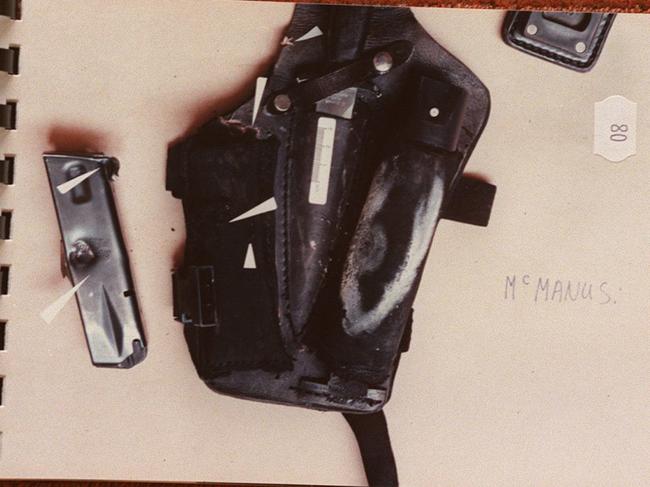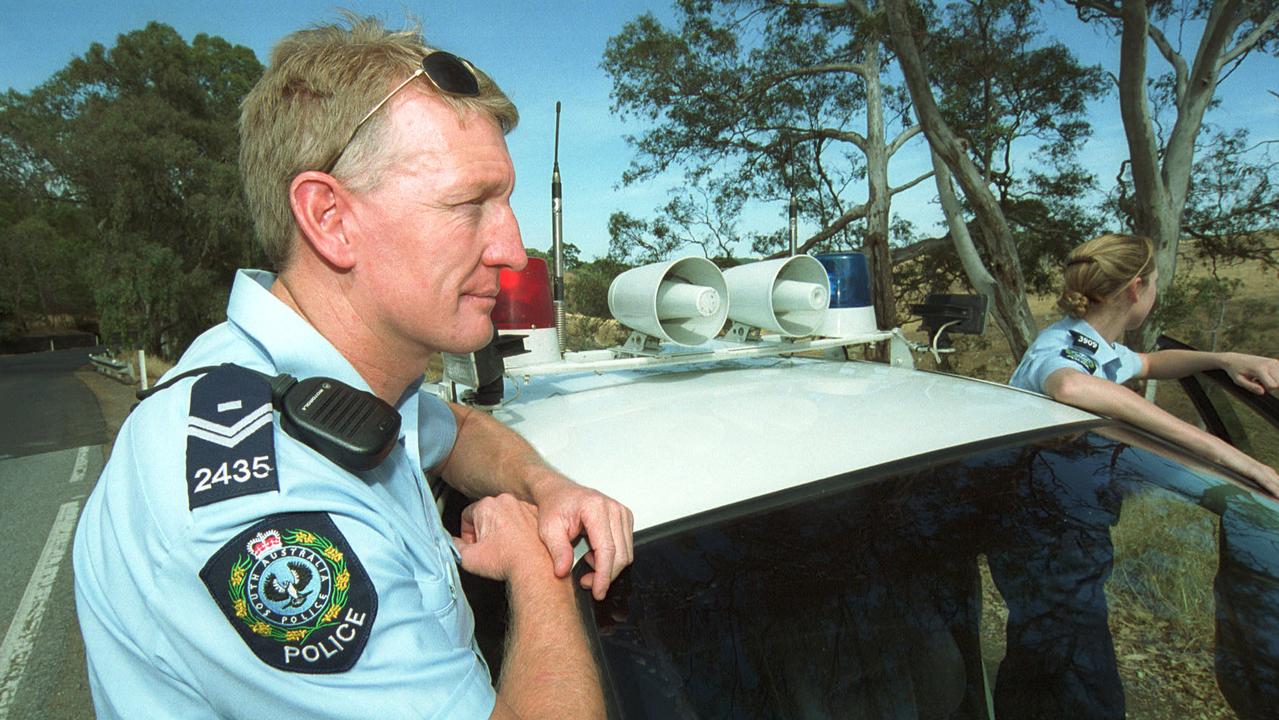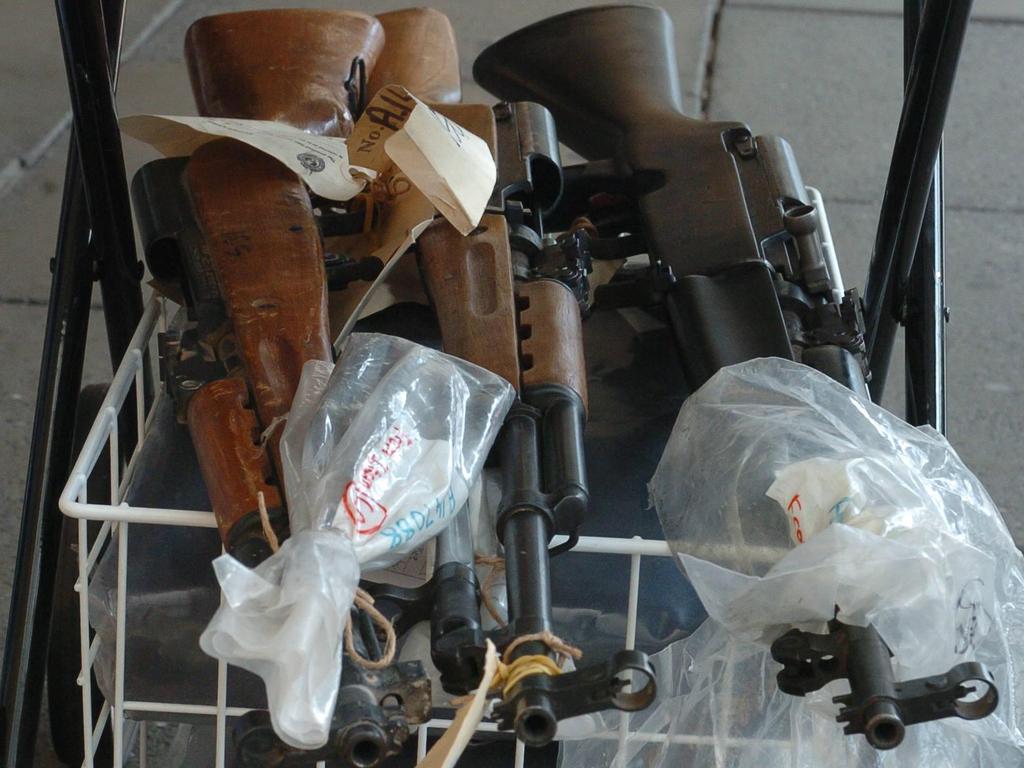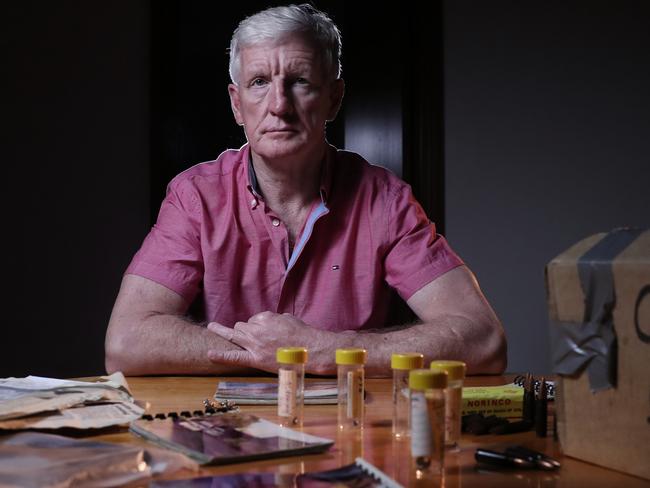Former South Australia STAR Group officer Derrick McManus was shot 14 times in five seconds by a high-powered semi-automatic rifle during a high-risk raid — and somehow survived to tell the tale. He reveals the impact it had 26 years on.
Not many people are shot 14 times with a high-powered rifle and live to tell their story.
Derrick McManus knew the job he and his colleagues were sent out on was high risk — after all it’s what his Special Tasks and Rescue (STAR) group trained for.
But this day would be different. This day would call on the veteran police officer to rely on every bit of training and instinct he could muster. And the faith that his fellow officers have his back and would simply not leave him to die alone.
STAR is an elite squad trained in multiple disciplines including sniper, underwater recovery and counter-terrorism.
“Everything that we do has an edge of danger. There’s no two ways about it,” McManus tells The Night Watch.
“We come in when the operations require more speciality or more skills than what the average police officer has.
“And we have snipers, we have dives, we have explosives experts.”
The events of 30 years ago are still vivid in McManus’ mind. So clear is he on that fateful day — it could have easily have happened yesterday.
LISTEN: Former SA Special Tasks and Rescue officer Derrick McManus tells The Night Watch how he was shot 14 times in 5 seconds by a high powered semi-automatic rifle during a high risk raid and somehow survived to tell the tale ...
A man named Tony Grosser was well known to Adelaide police — and the court system. Detectives wanted to talk to him about several accusations of fraud made against him.
But he had no interest in speaking with them – threatening to shoot any officer who stepped foot on his property. STAR was called to search his property and seize his firearms.
Not long after Grosser faced court charged with a staggering 179 fraud offences but he collapsed while in the dock and was taken to hospital.

When he failed to turn up to court the next day, a warrant for his arrest was issued.
McManus and his colleagues were again called — this time to arrest him.
McManus had been on duty but playing a game of police basketball when the call came through. Summoned back to work, McManus and four of his colleagues, as well as regular police officers and a cameraman were briefed before they made the 45 minute drive to Grosser’s remote property in the Barossa Valley, 60km from Adelaide.
Their initial plan of doing a “leopard crawl” – officers on their elbows, knees and belly – “moving slowly enough that you can get there without being seen, without being hurt and nobody knows you are there” was abandoned after Grosser spotted a local policeman in town following him.
“So we stopped,” McManus said.
“We regrouped and made sure the sniper was in place so we could know exactly what he was doing and how he was doing it. He went into the house and stayed there.”


As they pulled up to Grosser’s house — McManus remembers reaching for his radio on the seat next to him — but then deciding not to take it.
It would be a decision he would later regret.
While officers knocked on Grosser’s door, McManus moved to the side of the house and headed to a sliding door to find a safer way for his colleagues to storm the house if needed.
“I reached out towards the glass sliding door, and as I was reaching out, I suddenly had no idea of what was happening to me,” McManus recalled.
“And I just started falling to the ground and I started cursing myself. ‘How could I possibly be this stupid?’.”
It was as he was falling McManus noticed small round holes in the sliding door that weren’t there seconds earlier.
“And then I hear the sound of gunfire somewhere in the distance … I haven’t felt any pain, I haven’t felt any impact on me, but I’m falling stupidly for no reason,” he says.

And then it sunk in.
“The sound of that gunfire at that time was just pure crack, the crack bang of a gun being fired at close range,” he continues.
McManus realised he had been shot.
Not once but 14 times. Two bullets struck his left forearm – the force so great it breaks the bone – while another two bullets rip through his stomach, two hitting his left thigh, another bullet his right achilles tendon, three bullet to his left calf, a bullet striking his right knee and shrapnel lodging in his right wrist.
But it would be at least another three hours before he would know all of that.

McManus is still in the moment, reaching for his gun and firing back.
The shooting stops. He somehow rolls over and tries to get to his feet, calling out “I’m hit. I’m hit”.
“I don’t know whether the boys have heard me or not, but I move to the opposite direction to where they are.”
It’s the moment he regrets leaving his police radio in the car.
“I started thinking to myself ‘well that was a big mistake’, but I start moving away from the wall and I only take about two or three steps and my legs were so weak.
“I fall to my knees, I crawl along for two or three metres … wherever I go, there’s a trail of blood.”


And that’s when the panic set in. For the first time in his career, McManus found himself in a position where he couldn’t help himself.
“I literally was trying to think of ways that I can turn time back,” he admits.
“Do everything again but just not end up on this spot.”
But the sound of gunfire quickly snapped McManus back to reality. Grosser’s wife had escaped with her two children and ran towards police as he took refuge in the house’s roof and began shooting again.
For the next three hours McManus lay still on the ground — desperate to avoid being seen by Grosser but never losing hope that his colleagues would come for him.
As gunfire rang out around him McManus feared he wouldn’t make it.
Except he was no longer panicked.
“There were no threats. There was no terror. There was no anything,” he adds.
“But it was just this thought running through my mind ‘Is this it? Is this what they talk about? Is death coming for me now?’ And it was just this peaceful environment.
“As I’m lyin’ there, I could hear this automatic gunfire and I could hear the guys coming and what was running through my mind is when they get to me.
“I just want to be able to say something good to them … the first thing that came out of my mind was ‘thank the f**k you guys are here’.”

A doctor was waiting to treat McManus. So badly injured and drained of blood, the doctor initially thought McManus was dead.
“He worked on me for 10 minutes in direct line of fire … then he took me to the ambulance.”
The siege went on for 41 hours – the longest in South Australia’s history – before Grosser was finally arrested.
McManus needed six hours of surgery to sew his body back together and spent 28 days in hospital. He had to learn how to use his fingers again and would be another two and a half years before he would recover fully.
Throughout the entire ordeal, McManus’ wife and children were never far from his mind.
“The one thing that I wanted, the only thing I wanted was to be able to get back to my kids and interact with my kids in any way shape or form,” he said.
“I wanted to be there for their birthdays for their weddings for their trials and tribulations, just to be able to interact with them. It’s the one thing that kept me going.”
Even during painful physiotherapy sessions, McManus thought of his family.
“I just want to get back to my children and be able to run and hop and skip and jump with them if I possibly could. Anything better than that was always just going to be a bonus.”
It would be more than two years after the shooting before Grosser would face court. After a three month trial, Grosser was found guilty and sentenced to 22 years in jail.
But the ordeal wasn’t over with Grosser successfully appealing his conviction and a new retrial ordered.
That second trial went for 10 months, with Grosser representing himself. He was convicted and again sentenced to 22 years in prison.


Add your comment to this story
To join the conversation, please log in. Don't have an account? Register
Join the conversation, you are commenting as Logout